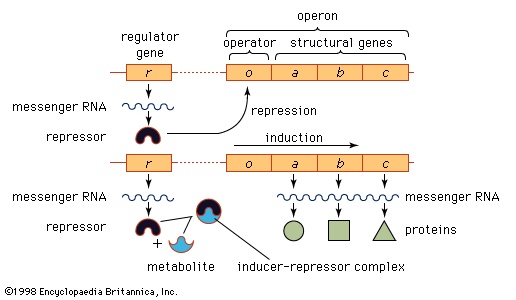operon
genetics
genetic regulatory system found in bacteria and their viruses in which genes coding for functionally related proteins are clustered along the DNA. This feature allows protein synthesis to be controlled coordinately in response to the needs of the cell. By providing the means to produce proteins only when and where they are required, the operon allows the cell to conserve energy (which is an important part of an organism's life strategy).
A typical operon consists of a group of structural genes that code for enzymes involved in a metabolic pathway, such as the biosynthesis of an amino acid. These genes are located contiguously on a stretch of DNA and are under the control of one promoter (a short segment of DNA to which the RNA polymerase binds to initiate transcription). A single unit of messenger RNA (mRNA) is transcribed from the operon and is subsequently translated into separate proteins.
 The promoter is controlled by various regulatory elements that respond to environmental cues. One common method of regulation is carried out by a regulator protein that binds to the operator region, which is another short segment of DNA found between the promoter and the structural genes. The regulator protein can either block transcription, in which case it is referred to as a repressor (repression) protein; or as an activator protein it can stimulate transcription. Further regulation occurs in some operons: a molecule called an inducer can bind to the repressor, inactivating it; or a repressor may not be able to bind to the operator unless it is bound to another molecule, the corepressor. Some operons are under attenuator control, in which transcription is initiated but is halted before the mRNA is transcribed. This introductory region of the mRNA is called the leader sequence; it includes the attenuator region, which can fold back on itself, forming a stem-and-loop structure that blocks the RNA polymerase from advancing along the DNA.
The promoter is controlled by various regulatory elements that respond to environmental cues. One common method of regulation is carried out by a regulator protein that binds to the operator region, which is another short segment of DNA found between the promoter and the structural genes. The regulator protein can either block transcription, in which case it is referred to as a repressor (repression) protein; or as an activator protein it can stimulate transcription. Further regulation occurs in some operons: a molecule called an inducer can bind to the repressor, inactivating it; or a repressor may not be able to bind to the operator unless it is bound to another molecule, the corepressor. Some operons are under attenuator control, in which transcription is initiated but is halted before the mRNA is transcribed. This introductory region of the mRNA is called the leader sequence; it includes the attenuator region, which can fold back on itself, forming a stem-and-loop structure that blocks the RNA polymerase from advancing along the DNA.The operon theory was first proposed by the French microbiologists François Jacob (Jacob, François) and Jacques Monod (Monod, Jacques) in the early 1960s. In their classic paper they described the regulatory mechanism of the lac operon of Escherichia coli, a system that allows the bacterium to repress the production of enzymes involved in lactose metabolism when lactose is not available.
- Helland-Hansen, Bjørn
- Hellanicus of Lesbos
- hellanodikai
- Hellas
- Hella S. Haasse
- hellbender
- Hell Creek Formation
- hellebore
- helleborine
- Hellen
- Hellenistic Age
- Hellenistic religion
- Hellenistic romance
- Hellens, Franz
- zone of avoidance
- Zonguldak
- Zonheboto
- zoning
- zoo
- zoochlorella
- zooflagellate
- zoogeography
- zoology
- Zoomastigophorea
- zoonosis